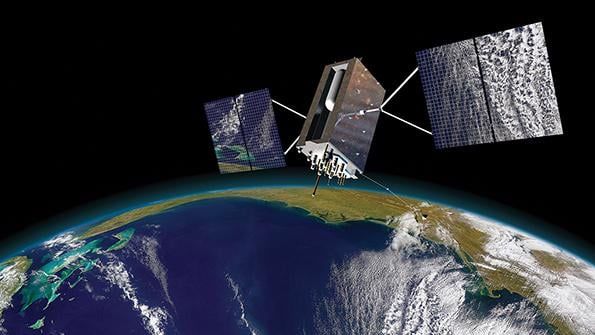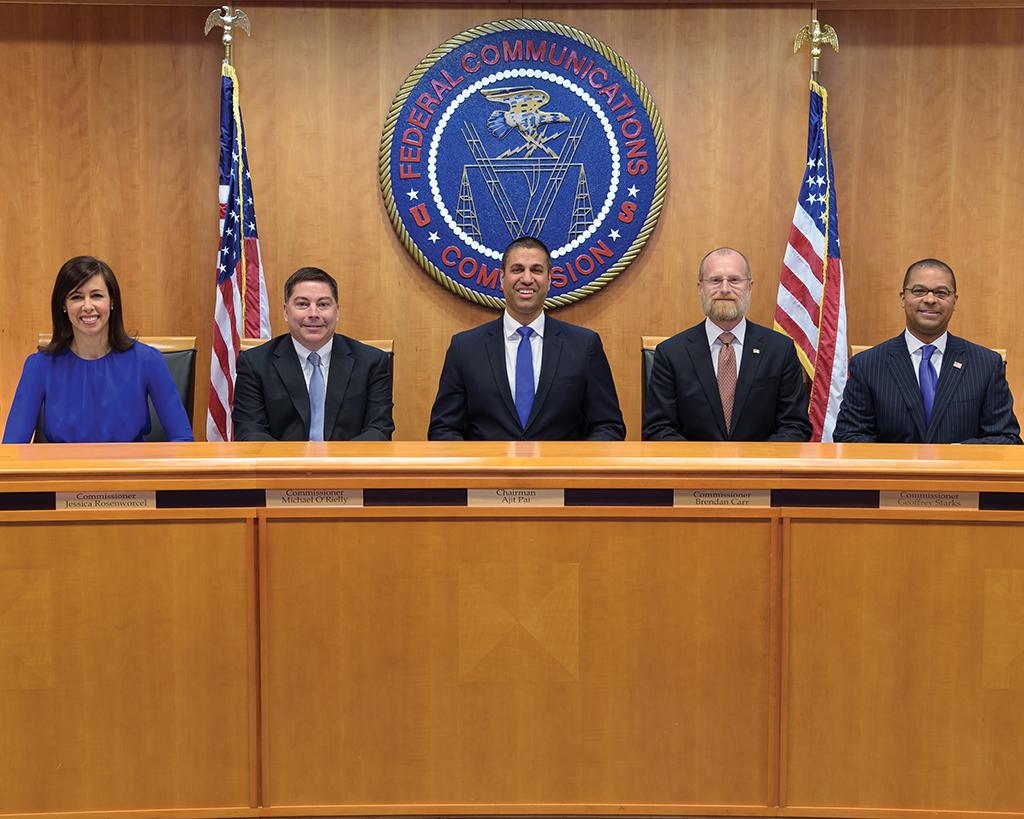
A controversial decision by the Federal Communications Commission (FCC) to approve, “with conditions,” Ligado Networks’ deployment of a 5G network using L-band spectrum between 1 and 2 GHz exposed deep disagreement within the U.S. government and failed to alleviate concern over interference with GPS signals at adjacent frequencies.
On April 20, the FCC voted unanimously to approve Ligado’s license modification applications to use mobile satellite services spectrum to roll out the low-power terrestrial network for 5G cellular and Internet of Things data services. Signaled days earlier when FCC Chairman Ajit Pai released a draft approval order, the decision ratified a network proposed a decade earlier by LightSquared, a predecessor company, amid a similar controversy.
- Ligado and GPS will share L-band spectrum
- Federal agencies register strong dissent
- U.S. attorney general cites technology competition with China
The FCC order allows Ligado to use the 1526-1536 MHz, 1627.5-1637.5 MHz and 1646.5-1656.5 MHz frequency bands. The GPS L1 signal is centered at 1575.42 MHz; the newer L2 signal operates at 1227.60 MHz.
The seemingly sudden resolution of a protracted and evolving spectrum licensing proceeding had powerful, politically bipartisan support, including from U.S. Attorney General William Barr, Secretary of State Mike Pompeo, and U.S. Sen. Mark Warner (D-Va.), a former telecommunications executive.
“Swift FCC action on spectrum is imperative to allow for the deployment of 5G,” said Barr after the release of Pai’s draft order. “This is essential if we are to keep our economic and technological leadership and avoid forfeiting it to Communist China.”
Freeing L-band spectrum for use in tandem with the C-band, as Pai has proposed, “would be a major step toward preserving our economic future,” added Barr, who in the past served as executive vice president and general counsel of Verizon Communications.
Arrayed in opposition were the bipartisan leadership of the House and Senate Armed Services Committees, House Transportation Committee Chairman Peter DeFazio (D-Ore.) and a veritable army of federal government agencies, aerospace companies and trade organizations.
Five days before the FCC’s vote on Ligado’s license modification applications, a coalition of aviation, satellite communications and weather information user companies delivered a letter to the agency, urging it to reject the proposed network.

“The commission and other stakeholders have now devoted over 9,000 pages of filings, multiple congressional hearings and countless meetings to addressing one company’s spectrum arbitrage effort, and the public has nothing to show for it,” the letter states.
“[G]iven Ligado’s failure to adequately address the harmful interference at the heart of its proposals and the convoluted and dated record for this proceeding, the most appropriate action for the FCC to take is to deny the Ligado applications by terminating the associated dockets.”
The coalition members include the Aerospace Industries Association, Iridium Communications, and Southwest Airlines, Delta Air Lines, JetBlue Airways and FedEx.
“We have spent billions of dollars and worked for 20 years to perfect a satellite service in satellite spectrum that’s proved critical in emergencies and disasters, all [assuming] that our government would ensure our operations would be protected,” tweeted Iridium CEO Matt Desch, who has sharply criticized the FCC proceeding. “Ligado’s scattered, low bandwidth-impaired spectrum has nothing to do with the global race to 5G.”
On April 10, the National Telecommunications and Information Administration (NTIA) submitted supplemental materials for the FCC to consider; the package followed a December 2019 correspondence that indicated the NTIA was “unable to recommend the commission’s approval of the Ligado applications.”
An agency of the Commerce Department, the NTIA chairs the federal government’s Interdepartment Radio Advisory Committee (IRAC), which represents the military services and executive branch agencies, including Barr’s Justice Department.
The second package from the NTIA included letters from the offices of the secretary and deputy secretary of defense, both expressing strong opposition to the Ligado license modification. A memorandum from Thu Luu, Air Force executive agent for GPS, advised that modifying or replacing legacy GPS receivers across the military to avoid adverse impacts from the new network “even if a solution were shown to be feasible, could take on the order of billions of dollars and delay fielding of modified equipment needed to respond to rapidly evolving threats by decades.”
The Transportation Department, the FAA’s parent organization and a member of the IRAC, provided Aviation Week a statement by Diana Furchtgott-Roth, deputy assistant secretary for research and technology.
“There is reason for significant concern that the FCC’s approval of the Ligado application could lead to widespread interruptions in essential GPS-dependent services,” said Furchtgott-Roth.
“GPS is used daily by Americans for all forms of transportation, both passenger and freight, in cars, trucks, buses, planes, rail and ships, as well as modern emergency response systems,” she added. ”GPS is the invisible utility we all take for granted, and the Federal government has a duty to public safety to ensure that GPS remains accurate and available.”
The two Democrats on the five-member, Republican-majority FCC board, Commissioners Jessica Rosenworcel and Geoffrey Starks, in a concurring statement described the April 20 decision as a close call. “In the end, we are compelled to support the expert technical analysis done by the FCC’s engineering staff” in green-lighting the Ligado network, they said.
But the process “has exposed a fault line in spectrum decision-making,” the commissioners added. “As we move to the next generation of wireless service, it is imperative that we have an improved interagency system and a stronger whole-of-government approach to our 5G effort.”
The FCC’s order mandates that Ligado provide a 23 MHz guard-band with its own licensed spectrum to separate its base station transmissions from nearby operations using radionavigation satellite service space-to-Earth allocations, including GPS. The company must limit its base station power levels to 9.8 dBW, a reduction of 99.3% from the levels proposed by Ligado in 2015, the agency says.
Transmitted power levers were evaluated in a GPS Adjacent-Band Compatibility Assessment by the Transportation Department, which addressed transmitters in bands adjacent to the 1559-1610 MHz band used for GPS L1 signals at 1572.42 MHz.
The study found that much of the noncertified GPS equipment used for general aviation aircraft and drones would experience interference more than a kilometer from a Ligado transmitter.
Avionics certified for instrument flight rules by the FAA were much less susceptible than noncertified avionics and would not experience interference unless a receiver were within 250 ft. of a transmitter, still a concern for police or emergency medical service (EMS) helicopters flying low-level missions, observes Dana Goward, president of the Resilient Navigation and Timing Foundation.
The Alexandria, Virginia-based foundation, which advocates for GPS system protections, has calculated that GPS-reliant helicopter terrain awareness and warning receivers would be unreliable for low-level missions in about 12% of an area served by Ligado Networks, based on the 433 m (1420.6 ft.) minimum spacing of its transmitters.
“I wouldn’t want to be an EMS helicopter pilot landing in unprepared areas and highways in the middle of the Ligado network,” says Goward, a pilot and retired Coast Guard captain. “I’ve landed on ships that are 210 ft. long and stayed overnight, so it’s not unreasonable to think that an EMS helicopter will be within 250 ft. of [Ligado] towers.”
Despite the FCC’s conditions, independent critics say the approval ignores the internationally accepted 1 dB Standard for radiofrequency-based services to protect GPS receivers from harmful interference.
The standard sets a 1-dB increase in the noise floor—the noise level that occurs naturally at a receiver—as the threshold between tolerable and harmful interference. This can be reliably measured by a 1-dB decrease in the signal carrier-to-noise ratio reported by the receiver, says the GPS Innovation Alliance (GPSIA).
The alliance planned to review the details of the approval but says it was “deeply disappointed” by the FCC’s decision.
“[The] GPSIA has consistently advocated for adoption of the 1 dB Standard as the only reliable mechanism that provides the predictability and certainty to ensure the continuation of the GPS success story,” Executive Director J. David Grossman said in a statement. “The 1 dB Standard for radiofrequency-based services is critical for Global Navigation Satellite Systems.”
Ligado rejects this argument. “They falsely claim that GPS receivers require protection in spectrum not assigned to GPS when the device-reported signal-to-noise ratio fluctuates by an amount as small as 1 dB. Seeking this type of protection in an adjacent band is unprecedented and unnecessary to ensure GPS continues to work,” states a video on the company’s website.
“In spectrum, the signal-to-noise is in a constant and perpetual state of fluctuation, often by much more than 1 dB. It’s normal,” Ligado adds.
Asked about the protection afforded by the 23 MHz guard band, Goward said: “It doesn’t matter how big your guard band is if your power is going to override it. Considering the power differential between Ligado and GPS, the guard band should probably be at least twice as big.”


